Cell Realizes Multilevel Savings
A three-tier flexible cell let this plant bring its build-to-order strategy to low-quantity parts. The cell realizes savings in terms of time, labor cost and responsiveness.
Share



.png;maxWidth=45)
DMG MORI - Cincinnati
Featured Content
View More
Hwacheon Machinery America, Inc.
Featured Content
View More
Takumi USA
Featured Content
View More

Autodesk, Inc.
Featured Content
View More
ECi Software Solutions, Inc.
Featured Content
View MoreThe Neptune Technology Group’s determination to adopt a build-to-order production strategy has swept like a wave across the Tallassee, Alabama, plant. Station after station has been transformed by this wave. Redesigned assembly areas now allow employees to build complex products in one place. Parts demanded in large quantities are now machined rapidly on a rotary transfer machine. All of these changes share the goal of letting manufacturing respond directly to a customer’s order, so that inventory isn’t needed.
The plant will continue to evolve and improve, but the fundamental changes necessary to achieve this build-to-order strategy are now nearly finished. One of the final changes involved cast and machined housing components that are needed in small quantities late in the process. Formerly milled and drilled in large batches on three stand-alone horizontal machining centers, these parts are now produced in a two-machine automated cell served by 36 pallets. The cell came from Toyoda Machinery (Arlington Heights, Illinois).
The cell stacks its pallets three tiers high, and this architecture is the most visibly striking feature of the system. The vertical design allows the plant to concentrate production flexibility within its limited floor space. Thanks to the stacking, 36 pallets occupy the floor space of only 12.
Brass Tactics
Neptune makes water meters. You probably have such a device in your home; it’s the meter that your water company reads to measure your usage. The unit in your home may have even been supplied by Neptune. The company makes residential meters, as well as meters that serve similar purposes in commercial applications.
The cast and machined components for these meters include main cases, covers and spacers that are all made from a lead-free brass alloy. The Toyoda cell has now taken over machining 30 of these part numbers, producing them in whatever small quantity is needed for the plant’s leadtime window—now just 2 or 3 days. Across two daylight shifts and an unattended shift at night, the cell continues running part numbers according to whatever job priorities are assigned within the cell controller software.
When it came time to get away from batch machining of these brass components—that is, when it came time to get away from inventory—the plant considered a variety of basic options. As an alternative to an automated cell, the plant evaluated using dedicated clusters of simpler, potentially smaller machining centers that were not integrated together. On the surface, this approach seemed like it might be more cost-effective. But manufacturing services manager Tom Crawford says that once the capital expense, floor space, maintenance, tooling and labor costs were all factored in, the automated cell proved to be the more economical choice.
The cell allowed the plant to keep its existing fixturing. Dedicating each of these fixtures to its own pallet determined how many pallets would be needed. For the number of machining centers, however, the company took advice from Toyoda. A simulation of 1 year of the plant’s production determined that just two machines could comfortably handle the load. Toyoda also rewrote the plant’s existing NC programs for the new machines. This rewriting, combined with faster rapid traverse, faster tool change and better rigidity, cut 25 to 30 percent from the cycle time for the average part, Mr. Crawford says.
The plant chose machines with 630-mm pallets—a large size that is appropriate to the plant’s largest fixtures. The plant’s older horizontals included a mix of sizes and therefore a mix of different-size fixtures, and on the new machines, some of the smaller fixtures presented opportunities.
One part number provides an example. The part was previously machined in sets of two workpieces per setup, but the new work zone offered room for three pieces per setup with little change in cycle time. In pursuit of efficiency gains such as this one, the plant ended up changing some of the fixturing it had preserved.
The cell’s flexibility also delivers efficiency gains. Thanks to the automation, the human operators have some comfort margin. For example, the cell cuts setup time to zero, because loading and unloading occur while machines are cutting. Even in cases when the machining cycle ends before the operator can load the next part, the cell still achieves zero setup time. It does this simply by skipping ahead, temporarily avoiding the job that isn’t ready in favor of the next available job in the queue. In this way, the cell keeps on producing through the operators’ breaks.
The production improvements extend beyond break times, however. One part that illustrates this requires side A and side B machining. An operator has to flip the part between cycles. In the past, the operator often was not available when the part was ready to be flipped in this way. The machine would wait, costing production time. Today, the operator still may not be available at just the right moment, but now that’s OK. The cell will keep on cutting, machining a different part number until the half-finished part can be re-loaded.
Going Unattended
The operators’ responsibilities now include preparing work for the nighttime shift. Running unattended is a new aspect of this part of Neptune’s process.
Mr. Crawford says, “When we first thought about running unattended, my concern was unexpected alarms—losing hours of production because of some control alarm that would have taken 30 seconds to clear.” On the older machines, certain periodic CNC alarms simply need to be cleared before production can continue—often with no effort more difficult than blowing a stray chip from a toolchanger switch. Mr. Crawford worried that similar alarms on the new machines would bring production to a halt while no operators were around.
However, the cell has run unattended without such interruptions. An even bigger fear expressed by some of the operators also has not materialized—that is, the fear that a crash would occur because the wrong pallet had been loaded for the NC program. The cell avoids this danger with a radio frequency ID system that double-checks each pallet’s identity against the program that is about to run.
The resulting reliability has delivered labor cost savings. In the past, Neptune had six employees covering three shifts machining these parts. While no one has lost a job because of automation in the plant, the plant has used attrition to adjust its staffing. Today, with the unattended shift, four employees now oversee the same work that the six employees did before.
Integrating Savings
Other savings come from the tight connection with the rest of the plant that a machine-to-order strategy makes possible. When the parts were machined in batches, the assembly operations could be starved or overwhelmed. Often there would be a mass of machined parts to store because assembly wasn’t ready for them. Just as often, there would be a long delay in assembly because the process was waiting for the next batch of some urgently needed part.
Upstream operations could also suffer. The on-site foundry was an example of this. To confirm the integrity of machined castings, parts are pressure tested after machining. A leak might indicate a foundry problem. When parts were machined in batches, a lot of pieces might be produced before an error such as this could be addressed.
Now, the overall process is more responsive. It is more responsive to the customer, delivering finished product to the customer more quickly. In addition, the cell helps make this process more responsive to itself, providing the kind of immediate feedback necessary
to keep production quality tightly controlled.
Read Next
The Post-Machine-Shop Process
Making the transition from batch production to a build-to-order strategy meant removing the kinds of barriers that separated machining from the rest of manufacturing.
Read More5 Rules of Thumb for Buying CNC Machine Tools
Use these tips to carefully plan your machine tool purchases and to avoid regretting your decision later.
Read MoreRegistration Now Open for the Precision Machining Technology Show (PMTS) 2025
The precision machining industry’s premier event returns to Cleveland, OH, April 1-3.
Read More



























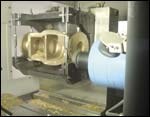
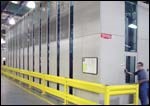
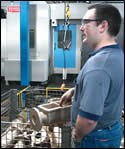
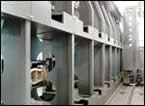
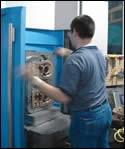















.jpg;maxWidth=300;quality=90)






